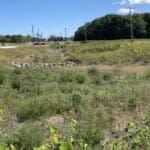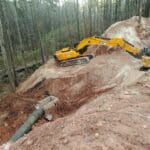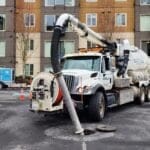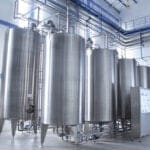City of New York City
New York City is adopting this new stormwater rule to reduce the adverse impacts on City sewers from runoff during rainstorms that are more severe than combined sewers are designed to handle and, to the greatest extent possible, maximize the capacity of these systems. Sewer overflows, floods, and sewer backups can occur when excessive stormwater from impervious surfaces enters too quickly into the combined sewer system. The new Stormwater Rule will allow the City to more effectively manage stormwater runoff from new developments and alterations in combined sewer areas by reinforcing, specifying and prescribing the methods and standards for the application, permitting, construction and inspection of sewer connections to the City sewer system. DEP expects the rule to:
- slow the flow of stormwater from sites,
- mitigate flooding and sewer backups,
- protect the sewer system, and,
- mitigate combined sewer overflows.
Background
Federal and State stormwater regulations continue to become more stringent, and discharges from combined sewer systems into the City’s surrounding water bodies affect attainment of Clean Water Act standards. In addition, changing precipitation patterns and associated flooding are increasing demand on the system, potentially limiting housing, business and other development. In response to these regulatory and weather trends, DEP has adopted a comprehensive, system-wide approach to reduce stormwater demands on the combined sewer system that includes source controls (including green infrastructure), conveyance, capture, and treatment. Federal and State regulation of the City’s separate sewer areas also continues to become more stringent, and the City expects new Municipal Separate Storm Sewer Systems (MS4) requirements to be published within the next year. Accordingly, the City will revisit this stormwater rule once MS4 obligations are settled in order to add any new stormwater requirements for separately sewered areas. At that time the City will also review how well stormwater controls are working in combined sewer areas.
The Final Rule
The Department of Environmental Protection is amending Chapter 31 of Title 15 of the Rules of the City of New York which regulates the construction, permitting, and inspection of sewer connections to the City sewer system.
The final rule will effectively apply to development on medium to large size lots. Smaller development sites would likely not generate runoff in excess of stormwater rule requirements and therefore would be expected to comply with current sewer availability and connection application process requirements.
Specifically, the final rule:
Sets forth a new performance standard which would apply to a new development or the alteration of an existing development in combined sewer areas of the City, as shown on the city sewer map which may be obtained at the respective local borough office of where the property/ development is located:
1. For a new development, the Stormwater Release Rate will be the greater of 0.25 cubic feet per second (cfs) or 10% of the Allowable Flow, unless the Allowable Flow is less than 0.25 cfs, in which case the Stormwater Release Rate shall be the Allowable Flow. (Allowable Flow means the stormwater flow from a development that can be released into an existing storm or combined sewer based on existing sewer design criteria.)
2. For Alterations, the Stormwater Release Rate for the altered area will be directly proportional to the ratio of the altered area to the total site area and no new points of discharge are permitted. (Alterations are as defined in the Construction/ Plumbing Codes and related requirements for any horizontal building enlargement or any proposed increase in impervious surfaces.)
- Clarifies that the overall site runoff coefficient can be reduced by maximizing open space, infiltration, and other techniques.
- Clarifies that stormwater management systems for developments that include multiple construction phases or subdivision of lots must be submitted to DEP for review and approval as a master/phased plan site connection application proposal.
- Establishes that, for proposed open-bottom detention systems, DEP will review requests for detention volume reductions through infiltration into soils. Such requests must be shown on Site Connection Proposal applications and substantiated by:
- soil borings taken at the location of the proposed system, and,
- a permeability test performed in situ to demonstrate that the existing soil below the system has a favorable rate of permeation.
- Establishes that DEP will review Site Connection Proposal applications that request detention volume reductions through dedicated systems and within certain conditions to recycle stormwater generated on the site.
- Clarifies that landowners and their successors must properly maintain on-site stormwater management systems, file a deed restriction, and submit triennial certification of proper operation.
- Clarifies and conforms to Department of Buildings Administrative Code Section 28-408.1 by defining the scope of plumbing work.
There are three changes in the Final Rule from the Proposed Rule which was published in September:
- Language has been added to section 31-02 to clarify current practice with regard to the calculation of allowable flow. This is consistent with New York State regulations.
- The provision in section 31-03(a) regarding alterations has been changed to improve clarity and to make the language in the rule and the Statement of Basis and Purpose consistent.
- Language allowing permeability tests to be performed at a laboratory has been deleted, as testing performed in situ is more accurate and reliable. Material to be added in the following rule is underlined, and material to be deleted is in [brackets].
§ 31-03 Stormwater performance standard for connections to combined sewer system.
(a) Stormwater release rate. The following provisions apply to the issuance of permits for sewer availability certifications and connections to combined sewer systems for new buildings and alterations as defined in the Construction/Plumbing Codes and related requirements for any horizontal building enlargement or any proposed increase in impervious surfaces.
(1) The Stormwater Release Rate must be no more than the greater of 0.25 cfs or 10% of the Allowable Flow or, if the Allowable Flow is less than 0.25 cfs, no more than the Allowable Flow.
(2) For Alterations, the stormwater release rate for the altered area must be no more than the stormwater release rate for the entire site, determined in accordance with subparagraph (1) above, multiplied by the ratio of the altered area to the total site area. No new points of discharge are permitted.
(3) For proposed open-bottom detention systems, applicants would be entitled to a reduction of the required stormwater volume to be detained where stormwater will be infiltrated into the below soils provided that the applicant demonstrates to the satisfaction of the department that the existing soil surrounding and below the system has a favorable rate of permeation substantiated by soil borings taken at the location of the proposed system in addition to a permeability test performed in situ. Requests for any volume credits must be shown on the site connection proposal application and reviewed by DEP.
(4) Applicants would be entitled to a reduction of the required stormwater volume to be detained where stormwater will be recycled for on-site uses provided that the department finds that the recycling system is independent and does not result in total site discharge to the sewer system greater than the Stormwater Release Rate at any time.
Such recycling systems cannot be modified or disconnected, without the express written approval of DEP. This restriction applies to both current and future owners and other persons in control of the property.
§31-03] §31-04 Standards for Issuance of Permits.
(a) Permits.
- No person or Owner shall connect to, make use of, or make an opening into any interceptor sewer, interceptor collector, sanitary, storm, or combined sewer or drain, or install, repair, relay or plug sewer connections, except upon issuance of a permit consistent with the provisions of this Rule. No sewer connections shall be permitted to any catch basin. Any such connection made without a permit shall be in violation of this Rule.
- Permits for a new connection or connections shown on certified sewer certification applications shall be required for the following:
- new developments;
- alterations performed on existing buildings, where sewer availability certification is required by the DOB;
- existing buildings served by cesspools or septic tanks to be connected to fronting sewers or drains; and
- unplugging and reuse of a plugged sewer connection.
- Plug permit(s) shall be required when an existing connection or connections are to be abandoned.
- Repair or relay permits shall be required for the repair or replacement of an existing sewer connection. Where realignment of the existing sewer connection or connections to new points of connection results in the plugging of an existing sewer connection or connections, no separate plug permit shall be required.
- Permits shall be required to install manholes on existing sewers or drains.
- Permits shall be required to install catch basins and catch basin connections outletting to existing sewers or drains, or an approved outlet.
- Permits shall be required to install seepage basins and catch basins outletting to such seepage basins.
- Any detention or retention system and any replacement of such a system proposed and implemented in order to comply with this rule must be properly maintained throughout the useful life of the system and maintenance records maintained, until replacement as approved by DEP. This obligation applies to current property owners, their successors, assigns, and other persons in control of the property, and shall be made binding in a deed restriction or other form satisfactory to DEP. Three years after the date of approval of a retention or detention system and every three years thereafter the operation of the system shall be inspected by a licensed professional engineer, a registered architect or a licensed master plumber. Such architect, engineer or master plumber shall submit certification to DEP that the system is free of debris and sediments, that its orifice is unobstructed and flowing and that the system is otherwise operating in compliance with this rule.
[§31-05] §31-07 Inspections.
- General Requirements.
- All sewer connections, including new connections, relays/repairs, plugs, catch basin and catch basin connections, and seepage basins shall be inspected and approved by an Inspector.
- A permittee shall be granted an inspection one business day following the request for such inspection.
- Prior to commencing excavation for sewer connections, the permittee shall verify that the sewer or drain is not surcharged, obstructed, or damaged. If the sewer is surcharged, obstructed, or damaged, the permittee shall not perform any work and shall immediately notify the DEP.
- No sewer connection or related work shall be inspected or approved by an Inspector unless the trench is open for any length of previously un-inspected work and all pipes, joints, and related work are visible. A suitable ladder affording safe access for such inspection shall be provided by the permittee. Trenches must conform to all applicable Rules, Regulations and laws regarding safety.
- An Inspector is required to be present during any drill-in to a sewer or drain.
- Any trench backfilled without completed inspection shall be re-excavated to the degree necessary as determined by the Inspector.
- Inspections will be conducted Monday through Friday (except on holidays) between the hours of seven (7) A.M. and four (4) P.M. Exceptions to this requirement may be granted upon traffic and work stipulations set forth by the DOT or other entity having jurisdiction or for other unforeseen circumstances, at the discretion of the DEP.
- No inspection shall be performed unless all permits and appropriate documentation required by the DEP are displayed at the work site. Such documentation shall include:
- the certified house connection proposal or certified site connection proposal, with all pertinent supporting documents where required;
- the approved permit application and sewer connection permit;
- the street opening permit from the DOT or other entity having jurisdiction, and when a Builder’s Pavement Plan has been required, an approved copy thereof;
- all approved shop drawings;
- all Mayor’s Traffic Construction Coordination Committee traffic stipulations, where weekend and/or night work is scheduled; and
- all applicable notarized affidavits regarding the reuse of existing connections.
- Certificate of Inspection.
- A certificate of inspection shall be issued for each permit granted by the DEP upon:
- successful completion of an inspection; and
- compliance with all applicable requirements in sections 31-04, [and]31-05, and 31-07 of this Rule.
- For sewer certifications with multiple permits, a certificate of inspection shall be issued for each unit.
- No certificate of inspection shall be issued unless all sewer work shown on the certified house connection proposal or site connection proposal has been completed and inspected.
[§31-06] §31-08 Repair Order.
- General Requirements.
1. When a sewer house connection, private pumping station, private sanitary ejector, private sanitary force main house connection , or a private force main is found to be leaking, inoperative or defective at a particular premises, the DEP shall issue a repair order to the Owner of such premises. The repair order shall instruct the Owner to make all necessary repairs and otherwise comply with the requirements of such order within 30 days of the date of issuance of such order, except when the DEP determines that there is an immediate danger to public health, property or to the environment, in which case such order may provide that repairs shall be made immediately upon issuance of such order. For purposes of this section, “ejector” shall mean a mechanical device used to pump or eject sewage.
- If the Owner has not complied with the repair order in the period allowed, the DEP shall shut off the water service tap/wet connection of the premises. All repair work concerning a sewer connection shall be performed by a Licensed Master Plumber, as provided herein.
- If an Owner believes that a repair order has been issued in error or that exigent circumstances exist such that shutting off the tap/wet connection of the premises would result in extreme hardship, the Owner may apply by letter to the Commissioner who shall make a final determination as to whether the repair order was issued in error or whether exigent circumstances exist warranting an abeyance of issuance of the repair order.
- A Licensed Master Plumber shall obtain a sewer connection repair permit prior to performing work pursuant to a repair order on a sewer connection or in compliance with sections [25-03]31-04 (a)(4) and [25-05]31-08 (a) of this Rule. Upon completion of all necessary repairs by the Licensed Master Plumber and approval by the DEP, a Licensed Master Plumber shall obtain a tap/wet connection permit to restore the water service.
- When the water service is shut off by the DEP, the Owner must engage a Licensed Master Plumber to assume responsibility for the excavation over the tap or wet connection. If the Owner fails to engage a Licensed Master Plumber, the water service will remain shut off, the excavation will be backfilled, and the street will be properly restored.
§ 2. This rule shall take effect six months after it is effective in accordance with the requirements of the city administrative procedure act except that the definitions of “code” and “non-plumbing work” as added by section 1 of this rule and the amendments to subdivisions (c) and (d) of section 31-04 of Title 15 of the Rules of the City of New York as renumbered and amended by section 1 of this rule shall take effect immediately upon their effectiveness in accordance with such act.
§ 3. If any provision of this rule or its application to any particular person or circumstance is held invalid, the remainder of this rule and its application to other persons and circumstances shall not be affected thereby.
Links:
New York City Stormwater Management Page
New York City Municipal Code
 Kenosha, Wis. Highway KR Regenerative Stormwater ConveyanceThe Root-Pike Watershed Initiative Network Kenosha County, and others worked with AQUALIS to design and implement an innovative solution for stormwater control along Highway KR.
Kenosha, Wis. Highway KR Regenerative Stormwater ConveyanceThe Root-Pike Watershed Initiative Network Kenosha County, and others worked with AQUALIS to design and implement an innovative solution for stormwater control along Highway KR. Durham, N.C. Sinkhole Leads to Stormwater System RehabilitationThe tenant on this property noticed a depression that opened to the ground below and notified the property owners.
Durham, N.C. Sinkhole Leads to Stormwater System RehabilitationThe tenant on this property noticed a depression that opened to the ground below and notified the property owners.
